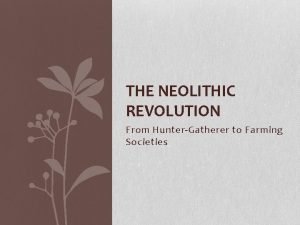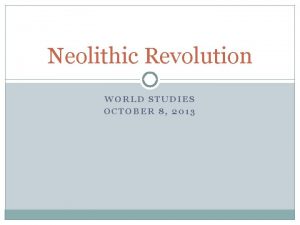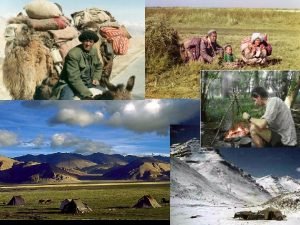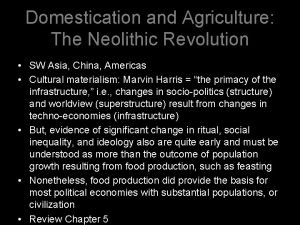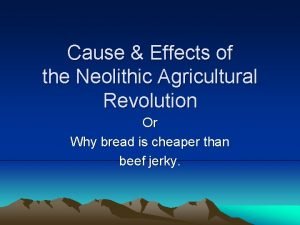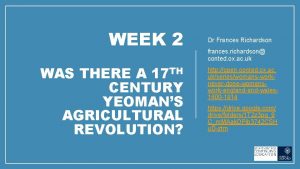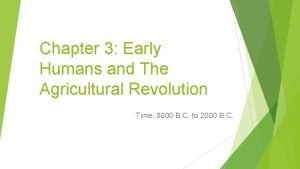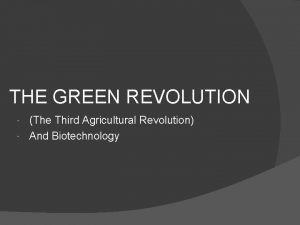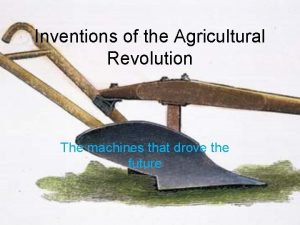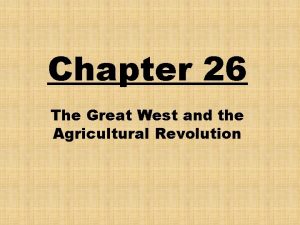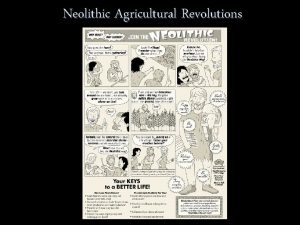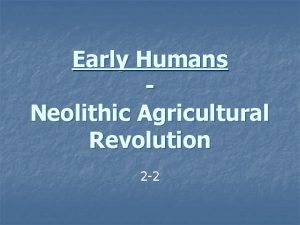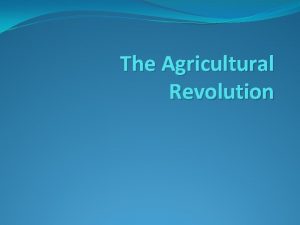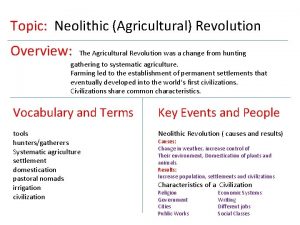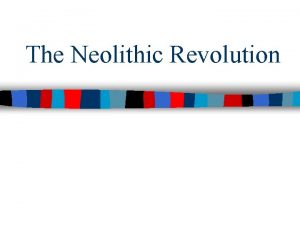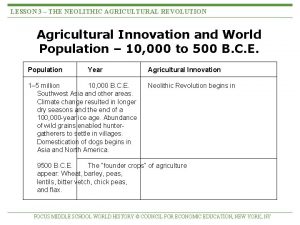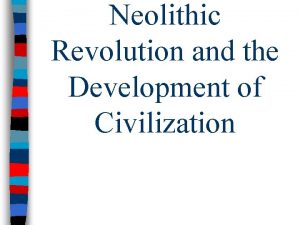Neolithic Revolution Agricultural Revolution Adapted from http intra
















- Slides: 16

Neolithic Revolution (Agricultural Revolution) Adapted from: http: //intra. burltwpsch. org/users/rlee/apworld. htm

Pre-Revolution • For 99% of human existence, our forbears lived by hunting and foraging • These individuals were tied to the seasons of plant foods and the movements of animals • Deliberated cultivation of food (beginning of food production) began about 10, 000 years ago > called the Neolithic Revolution • The development of agriculture most clearly moved humans toward a more sophisticated social and cultural patterns

What is an agricultural society? • Humans settle in one spot and focus on particular economic, political, and religious goals and activities • Most people are farmers production of food is the number 1 economic activity

Initial Development • Neolithic Revolution was triggered by two results of the end of the ice age – population increase – the retreat of big game animals like the mastodon • now hunters had to turn to smaller game like deer and boar • increasingly humans became dependent on regular harvests of wild grains, berries and nuts (foraging) • this set the stage for the deliberate planting of seeds

Domestication of Animals – First domesticated animal - dog: Why? > for hunting. – other animals were also domesticated in the Middle East and parts of Asia by 9000 BCE pigs, sheep, goats, cattle – Pastorialism way of life dependent on large herds of stock

Where did farming initially develop? – Middle East as early as 10, 000 BCE in the "fertile crescent" of the Tigris and Euphrates Rivers – This area was very fertile in that time – Grains abundant emmer wheat, barley, oats, rye as well as pulses (legumes)

Timeline – pages 2 & 3 • gradually agriculture spread to India, North America, Europe over a period of 2000 to 3000 years

Development of Agriculture • Neolithic means New Stone • Not a sudden revolution • Began around 8000 BCE

Why is it a true “revolution”? • Agriculture supported far more people per square mile than hunting ever could • Allowed people to settle permanently • Not easy require more work • Supported people with better food supplies • Villages appeared basis for future civilizations

New Tools Were Required • • 1. Stone heads on sticks to work soil 2. Sharp stone chips in handle to cut grain 3. Stone mortar to grind grain 4. FIRE

Drawback of Settlement • concentrated populations encouraged spread of contagious disease • In short, Agriculture Basis for More Rapid Change in Human Societies

Results of the "Agriculture Revolution" – greater wealth – because of larger populations specialization – control over nature – promoted early forms of science/technology

Major Changes: • Discovery of metal tools around 4000 BCE (copper first then bronze • 3000 BCE metalworking became so common that stone tools disappeared in the Middle East • Metalworking became extremely useful to agricultural and herding societies – 1. Metal hoes allowed farmers to work ground better – 2. Metal weapons – 3. Development of tool-maker class of people

Characteristics of a Civilization 1. Complex Institutions A. Government – can range from being very basic to very complex B. Religion/belief systems - a civilization usually is comprised of people who share similar beliefs. It may vary somewhat among the people but usually there is a core belief that often is reflected in their religious beliefs as well.

Characteristics of a Civilization 2. Record keeping – some form of written language for record keeping became necessary. Why? 3. Specialization or division of labor in jobs – the breakdown of work into its tasks or parts and assigned to various people or groups for the purposes of efficiency

Characteristics of a Civilization 4. Social classes or social hierarchy – in different civilizations, this can be determined on different things, including: wealth, power, different ethnicity, etc. 5. Advanced Technology - Sometimes this means inventions, sometimes it means things like art and/or architecture – an appreciation or development of something that is more than just basic.
 Third agricultural revolution
Third agricultural revolution New stone age characteristics
New stone age characteristics Why was the neolithic revolution a turning point
Why was the neolithic revolution a turning point Neolithic revolution definition
Neolithic revolution definition Whats neolithic revolution
Whats neolithic revolution Four tigers definition ap human geography
Four tigers definition ap human geography Neolithic revolution
Neolithic revolution What was the neolithic revolution? *
What was the neolithic revolution? * Neolithic revolution
Neolithic revolution Lesson 2 the neolithic revolution
Lesson 2 the neolithic revolution Neolithic revolution
Neolithic revolution Cause and effect of the agricultural revolution
Cause and effect of the agricultural revolution The agricultural revolution
The agricultural revolution Chapter 3 early humans and the agricultural revolution
Chapter 3 early humans and the agricultural revolution Green revolution advantages and disadvantages
Green revolution advantages and disadvantages Agricultural revolution inventions
Agricultural revolution inventions Chapter 26 the great west and the agricultural revolution
Chapter 26 the great west and the agricultural revolution



